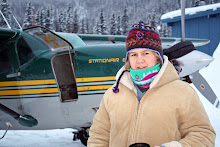Hooper Bay Trip Report
 I spent last weekend in the Eskimo village of Hooper Bay. I am, again this year, volunteering with the Volunteer Tax & Loan Program (VLTP) as a supervisor for a couple of tax trips. The program sends teams of tax preparers (often college students) along with a logistics supervisor (my role) to many remote villages around the state of Alaska to help the village residents with their tax returns.
I spent last weekend in the Eskimo village of Hooper Bay. I am, again this year, volunteering with the Volunteer Tax & Loan Program (VLTP) as a supervisor for a couple of tax trips. The program sends teams of tax preparers (often college students) along with a logistics supervisor (my role) to many remote villages around the state of Alaska to help the village residents with their tax returns.Last year, I went to Grayling and Holy Cross over the course of a single weekend. The weekend trips depart on Friday morning and return Sunday evening. This means I have to miss a day of work for each weekend I participate. This year, I’m doing two trips. Last weekend was in Hooper Bay and in another week, I’ll be headed to Newtok.
 Both of these villages are on the western coast of Alaska. Both are populated by mostly Yup’ik Eskimos. In Hooper Bay, I travelled with a team of 3 University of Alaska-Anchorage (UAA) accounting students. Often there are only 2 tax preparers on a team. But Hooper Bay is the largest village in western Alaska with over 1000 residents.
Both of these villages are on the western coast of Alaska. Both are populated by mostly Yup’ik Eskimos. In Hooper Bay, I travelled with a team of 3 University of Alaska-Anchorage (UAA) accounting students. Often there are only 2 tax preparers on a team. But Hooper Bay is the largest village in western Alaska with over 1000 residents.There is running water in the village of Hooper Bay. However, not every building is served by it. The building in which we stayed and worked had water in the sinks which drained directly into a bucket below. The buckets had to be emptied outdoors lest they overflow (which they did a couple times). There is also an incinerator toilet in the building, but it had a nice sign duct taped to it stating that it was “Out of Order 2010”. Sitting on the floor in front of the dysfunctional toilet was the more common facility, the honey bucket. For those who have not had the pleasure of using a “honey bucket”, this is basically a 5-gallon bucket with a fitted plastic seat and lid. We shared this bucket with the entire village as they came in to have their taxes done. But like a parent comes to terms with bodily excrements about 5 minutes after their first child is born, it is similarly possible to deal with the honey bucket. It does, however, make one appreciate your own humble toilet once you arrive back home.
 The most common mode of transportation in the village seemed to be split evenly between snowmachines and 4-wheelers. I saw 2 trucks in the village. One looked like it might actually run. Our transfer to and from the airstrip was via a 4-wheeler pulling a trailer.
The most common mode of transportation in the village seemed to be split evenly between snowmachines and 4-wheelers. I saw 2 trucks in the village. One looked like it might actually run. Our transfer to and from the airstrip was via a 4-wheeler pulling a trailer.I’ve posted several photos of the trip to my Facebook. Here’s the link:
http://www.facebook.com/album.php?aid=148371&id=523908158&l=6cd51e1501


1 Comments:
Beautiful location. Wouldn't wanna live there because to remote but nice to visit.
I bet you will miss the honey bucket. :o)
Rebecca
Post a Comment
<< Home